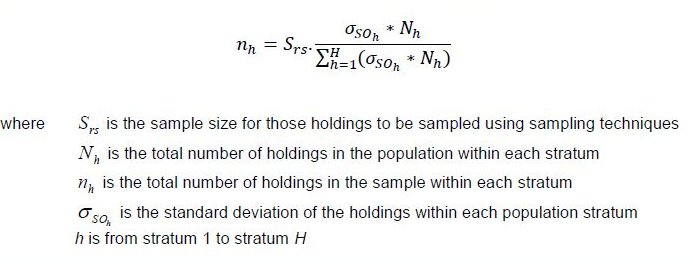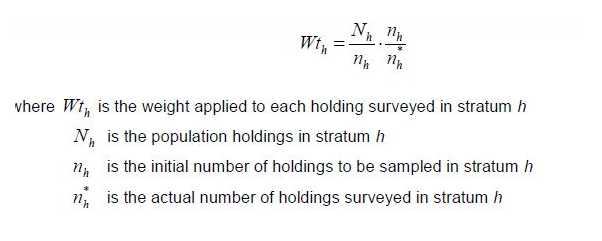| 1. Source of data |
| The FSS 2016 was based on a sample survey. Some of the variables were obtained directly from the administrative sources. |
| 2. (Sampling) frame |
| The sample of the FSS was chosen from the farm register. The Unit maintains the agricultural register, which consists of a central database having the personal details of the holding and the data from previous surveys. This enables the unit to compile and extract an updated list of holdings for the FSS. No threshold is applied to the register. The agricultural register is updated frequently and new units may be traced from surveys carried out directly by the Unit and other administrative sources. |
| 3. Sampling design |
| 3.1 The sampling design |
| One-stage stratified random sampling of holdings. |
| 3.2 The stratification variables |
| The sample was stratified by farm type, economic size and region. Maltese agriculture is diverse and limited in size. As a result, it was not feasible to sample all farm types at the 3-digit level of typology. In order to overcome this phenomenon and to obtain a representative sample from each stratum, certain farm types were grouped according to the following typology codes.
| Farm type |
Typology codes |
| 1 |
161, 166, 615, 833, 843 |
| 2 |
211, 212, 213, 221, 222, 223, 231, 232, 233, 611, 612, 616 |
| 3 |
351, 352, 353, 354, 613 |
| 4 |
361, 362, 365, 370, 380, 614 |
| 5 |
450, 460, 470, 841, 842 |
| 6 |
481, 482, 483, 484, 741, 834, 844 |
| 7 |
511, 512, 513, 521, 522, 523, 530, 731, 732, 742 |
Besides, the economic size classes were grouped as follows: 1-3, 4-7, >=8.
| |
Lower limit of the economic size classes |
Upper limit of the economic size classes |
| 1-3 |
|
8,000 |
| 4-7 |
8,000 |
100,000 |
| >=8 |
100,000 |
|
|
| 3.3 The full coverage strata |
| There are two full coverage strata. |
| 3.4 The method for the determination of the overall sample size |
| The overall sample size of the holdings to be sampled has been always 1,500. With such an amount, the sample precision is always 0.8 per cent. |
| 3.5 The method for the allocation of the overall sample size |
| The optimum allocation method was the preferred method for selecting agricultural holdings by minimising the variance within the strata. Thus, the holdings in each stratum, except for those exhaustively surveyed, were chosen on the proportion of the total standard deviation of the total standard output of the holdings within each stratum. The formula for extracting the number of holdings to be surveyed under the optimum allocation method is:  |
| 3.6 Sampling across time |
| A new sample is chosen for every survey. |
| 3.7 The software tool used in the sample selection |
| Microsoft Excel |
| 3.8 Other relevant information, if any |
| Not available. |
| 4. Use of administrative data sources |
| 4.1 Name, time reference and updating |
| Bovine Register - The Bovine Register which is maintained by the Veterinary Regulatory Directorate at the Civil Abattoir within the Ministry of Sustainable Development, Enviroment and Climate change was set up in 2002 in accordance with Regulation (EC) 1760/2000 (establishing a system for the identification and registration of bovine animals and regarding the labelling of beef and beef products). Identification and registration of all animals is carried out and registered in the database. Decision 2004/588/EC recognises the fully operational character of the Maltese database for bovine animals. Organic Register - The organic register is in accordance with the Council Regulation No. 834/2007. Data in the organic register is updated during the year and the list is forwarded to our office. The Standards and Metrology Institute within the Malta Competition and Consumer Affairs Authority is the office responsible to grant certification or not to farmers. Periodic surveillance visits (at least annually) are carried out on certified organic farms / producers. Clients are required to keep all records on how they grow or process organic products, what chemicals, fertilizers, etc. are in use. Such records are inspected on every visit and tests for illegal use of pesticides, chemicals, etc. are carried out when it is suspected or complaints are received that the client is not practicing organic farming as required by Council Regulation (EC) No. 834/2007. Paying Agency - The paying agency, operates an effective administrative set-up to ensure an efficient, effective and timely processing of claims and to provide accurate and timely information to the Commission, the local entities and to the farming community. The Paying Agency is set up in accordance with Regulation (EU) No. 1306/2013 of the European Parliament and of the Council and Commission Regulations (EC) No. 883/2006 and 885/2006. |
| 4.2 Organisational setting on the use of administrative sources |
| In article 38 of the Malta Statistics Authority Act: Notwithstanding anything contained in any other law enjoining secrecy, any person or undertaking who holds records from which, in the opinion of the Director General, information relating to matters specified in the First Schedule can be obtained, shall grant to the Director General or an officer of statistics access to such records for obtaining the said information. We do not participate in the conceptual design of the administrative sources. |
| 4.3 The purpose of the use of administrative sources - link to the file |
| Please access the information in the file at the link: (link available as soon as possible) |
| 4.4 Quality assessment of the administrative sources |
| |
Method |
Shortcoming detected |
Measure taken |
| - coherence of the reporting unit (holding) |
In Malta the definition of the agricultural holding is the same as the one in the Regulation 1166/2008. |
- |
|
| - coherence of definitions of characteristics |
|
Bovine Register: In the bovine register there is not any distinction between heifers, dairy cows and other cows since females bovines are classified only in 2 categories. |
Bovine Register: In the census of agriculture 2010 we have collected detailed cattle data directly from the farms. From such data we have obtained the respective coefficient which is used to have the breakdown. |
| - coverage: |
|
|
|
| |
over-coverage |
|
- |
|
| |
under-coverage |
Bovine register: The bovine register held in Malta is according to Regulation (EC) No 1760/2000 and Regulation (EC) No 911/2004. All the movements from one farm to another are only authorised by the animal health section. All this information is recorded. |
Farm Register:
Regarding sheep and goats, at the moment there could be households that have sheep and/or goats which are not covered by the farm register. But there is a total coverage of over 80 per cent in the farm register. |
|
| |
misclassification |
|
- |
|
| |
multiple listings |
|
- |
|
| - missing data |
|
- |
|
| - errors in data |
|
- |
|
| - processing errors |
|
- |
|
| - comparability |
|
- |
|
| - other (if any) |
|
- |
|
| 4.5 Management of metadata |
| The metadata of the administrative sources is available in electronic format and it is updated over time. |
| 4.6 Reporting units and matching procedures |
In Malta the definition of the agricultural holding is the same as the one in the Regulation 1166/2008.
The data from the administrative sources is linked with the farmer ID card for the paying agency and organic register. In the sample chosen there was only 4 farmers that are certified organic or are in conversion to organic.
For the bovine register the data is linked with the licence number as all cattle breeders have a licence. |
| 4.7 Difficulties using additional administrative sources not currently used |
| Not relevant. |
|





 is the weight applied to each holding surveyed in stratum h,
is the weight applied to each holding surveyed in stratum h, is the number of holdings in stratum h,
is the number of holdings in stratum h, is the variance within stratum h.
is the variance within stratum h.